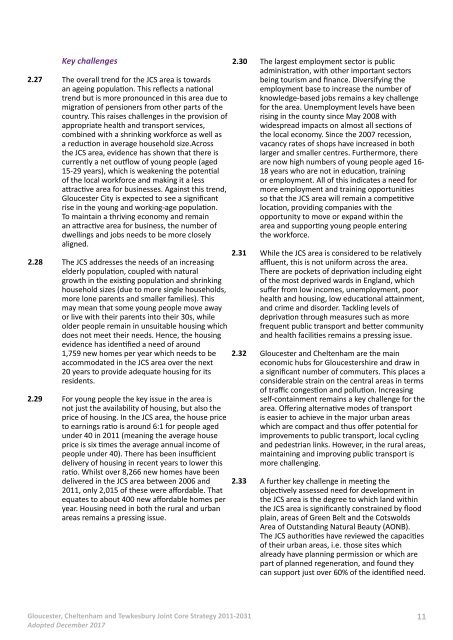JCS_MasterDocument_FIN_27.03.18
Create successful ePaper yourself
Turn your PDF publications into a flip-book with our unique Google optimized e-Paper software.
2.27 The overall trend for the <strong>JCS</strong> area is towards<br />
an ageing population. This reflects a national<br />
trend but is more pronounced in this area due to<br />
migration of pensioners from other parts of the<br />
country. This raises challenges in the provision of<br />
appropriate health and transport services,<br />
combined with a shrinking workforce as well as<br />
a reduction in average household size.Across<br />
the <strong>JCS</strong> area, evidence has shown that there is<br />
currently a net outflow of young people (aged<br />
15-29 years), which is weakening the potential<br />
of the local workforce and making it a less<br />
attractive area for businesses. Against this trend,<br />
Gloucester City is expected to see a significant<br />
rise in the young and working-age population.<br />
To maintain a thriving economy and remain<br />
an attractive area for business, the number of<br />
dwellings and jobs needs to be more closely<br />
aligned.<br />
2.28<br />
2.29<br />
Key challenges<br />
The <strong>JCS</strong> addresses the needs of an increasing<br />
elderly population, coupled with natural<br />
growth in the existing population and shrinking<br />
household sizes (due to more single households,<br />
more lone parents and smaller families). This<br />
may mean that some young people move away<br />
or live with their parents into their 30s, while<br />
older people remain in unsuitable housing which<br />
does not meet their needs. Hence, the housing<br />
evidence has identified a need of around<br />
1,759 new homes per year which needs to be<br />
accommodated in the <strong>JCS</strong> area over the next<br />
20 years to provide adequate housing for its<br />
residents.<br />
For young people the key issue in the area is<br />
not just the availability of housing, but also the<br />
price of housing. In the <strong>JCS</strong> area, the house price<br />
to earnings ratio is around 6:1 for people aged<br />
under 40 in 2011 (meaning the average house<br />
price is six times the average annual income of<br />
people under 40). There has been insufficient<br />
delivery of housing in recent years to lower this<br />
ratio. Whilst over 8,266 new homes have been<br />
delivered in the <strong>JCS</strong> area between 2006 and<br />
2011, only 2,015 of these were affordable. That<br />
equates to about 400 new affordable homes per<br />
year. Housing need in both the rural and urban<br />
areas remains a pressing issue.<br />
2.30<br />
2.31<br />
2.32<br />
2.33<br />
The largest employment sector is public<br />
administration, with other important sectors<br />
being tourism and finance. Diversifying the<br />
employment base to increase the number of<br />
knowledge-based jobs remains a key challenge<br />
for the area. Unemployment levels have been<br />
rising in the county since May 2008 with<br />
widespread impacts on almost all sections of<br />
the local economy. Since the 2007 recession,<br />
vacancy rates of shops have increased in both<br />
larger and smaller centres. Furthermore, there<br />
are now high numbers of young people aged 16-<br />
18 years who are not in education, training<br />
or employment. All of this indicates a need for<br />
more employment and training opportunities<br />
so that the <strong>JCS</strong> area will remain a competitive<br />
location, providing companies with the<br />
opportunity to move or expand within the<br />
area and supporting young people entering<br />
the workforce.<br />
While the <strong>JCS</strong> area is considered to be relatively<br />
affluent, this is not uniform across the area.<br />
There are pockets of deprivation including eight<br />
of the most deprived wards in England, which<br />
suffer from low incomes, unemployment, poor<br />
health and housing, low educational attainment,<br />
and crime and disorder. Tackling levels of<br />
deprivation through measures such as more<br />
frequent public transport and better community<br />
and health facilities remains a pressing issue.<br />
Gloucester and Cheltenham are the main<br />
economic hubs for Gloucestershire and draw in<br />
a significant number of commuters. This places a<br />
considerable strain on the central areas in terms<br />
of traffic congestion and pollution. Increasing<br />
self-containment remains a key challenge for the<br />
area. Offering alternative modes of transport<br />
is easier to achieve in the major urban areas<br />
which are compact and thus offer potential for<br />
improvements to public transport, local cycling<br />
and pedestrian links. However, in the rural areas,<br />
maintaining and improving public transport is<br />
more challenging.<br />
A further key challenge in meeting the<br />
objectively assessed need for development in<br />
the <strong>JCS</strong> area is the degree to which land within<br />
the <strong>JCS</strong> area is significantly constrained by flood<br />
plain, areas of Green Belt and the Cotswolds<br />
Area of Outstanding Natural Beauty (AONB).<br />
The <strong>JCS</strong> authorities have reviewed the capacities<br />
of their urban areas, i.e. those sites which<br />
already have planning permission or which are<br />
part of planned regeneration, and found they<br />
can support just over 60% of the identified need.<br />
Gloucester, Cheltenham and Tewkesbury Joint Core Strategy 2011-2031<br />
Adopted December 2017<br />
11




